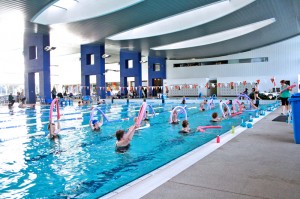Fibromyalgia patients report feeling fewer and milder fibromyalgia chronic pain symptoms with routine gentle workouts.
Fibromyalgia, or Fibromyositis (FMS), is a debilitating condition in which sufferers often feel excruciating pain for little or no apparent reason.
Other symptoms might include depression, insomnia, and chronic fatigue syndrome (CFS), also referred to as myalgic encephalomyelitis (ME/CFS) or chronic fatigue and immune dysfunction syndrome (CFIDS).
If you suffer from long-term chronic pain in your muscles, joints, or other areas of your body, yet are unable to isolate any injury whatsoever, then you should visit your doctor and ask for a fibromyalgia screening. Although scientists are still at a loss to explain the causes of fibromyalgia, they have found some effective fibromyalgia treatments to help you cope with the symptoms, including some fibromyalgia approved fitness exercises.
Suffering from Fibromyalgia and Chronic Fatigue? B12 to the Rescue!
Which workout is right for you?
Finding the right workout routine with fibromyalgia or chronic fatigue can be intimidating.
On the one hand, even the slightest amount of physical activity leaves you feeling worn out, exhausted, achy, and ill. This phenomenon, “Post-exertional malaise,” often deters fibro sufferers from staying active. However, you can eventually build up your tolerance to post-workout fatigue and slowly raise your endurance level to many kinds of aerobic exercises and strength training.
Many fibromyalgia patients who successfully get past that first “hurdle” report feeling fewer and milder fibromyalgia pain symptoms.
7 Reasons You Have Brain Fog…And What to do About It
Below are some light exercises that you can practice 3-5 days per week. As with any new fitness program, consult your doctor first.
1- Bike Riding: Bicycle riding is a fun exercise that can be adapted to suit many levels. Start out small- avoid hilly areas, choose a short-term goal, such as circling the block once, and pace yourself.
2- Stationary Bike: If you belong to a gym, sign up for a beginners spinning class. There are also many virtual spinning classes, both on YouTube and DVD, which can provide a great home workout.
3- Walking: Walking is a great low-impact sport for pain sufferers. Invest in a good pair of walking shoes, pick a comfortable route, and grab a friend! People who walk in pairs are more likely to stick to their routine, and find it easier to complete their workout. If weather permits, take a nice nature walk or stroll in the sunshine, but if it doesn’t, you can still hit the indoor mall before the morning rush for a bit of brisk “window shopping.”
4- Jogging: Light jogging is like running, only more controlled and less strenuous. If you want to increase your energy without compromising your leg muscles, then try alternating five minutes of jogging with five minutes of brisk walking, and work up to fifteen-minute sessions of each. Choose soft, grassy, or sandy paths, if possible, and try to avoid jogging on hard surfaces, which can cause knee injuries.
Can a Gluten-Free Diet Ease Symptoms of Fibromyalgia?
5- Treadmill: Walking on the treadmill is a great indoor alternative to stationary biking, and an excellent way to get the heart pumping. As with jogging, be on the alert for any sign of swelling, which could indicate knee injury.
6- Swimming: Swimming is one the best, non-injurious cardiovascular workouts for people who suffer from chronic pain, particularly arthritis. Individuals who have difficulty with most types of physical activity often have an easier time incorporating water aerobics or lap swimming into their daily workout.
7- Golfing: Golfing is an enjoyable sport, but it can be strenuous on the lower back muscles. Get your doctor’s okay before heading out for the golf course. Avoid the urge to join the caddy, and walk your way around the greens for a low-impact aerobic workout.
8- Physical Therapy: A certified physical therapist can teach you how to relieve some of your pain symptoms, enabling you to stick to your daily workout.
9- Yoga: Yoga combines therapeutic deep breathing with gentle stretching of your various muscles, for a relaxing, healing bodily workout. Many fibromyalgia patients have reaped the benefits of yoga in alleviating their chronic pain symptoms.
10- Pilates: Pilates focuses on developing core muscular strength and flexibility, as opposed to merely stretching the muscles. Developed by Joseph Pilates, Pilates is a beneficial exercise for fibromyalgia and chronic fatigue syndrome patients.
Do not attempt to practice Pilates on your own; a trained Pilates instructor is crucial, in order to avoid injury.
11- Stretching: Stretching exercises are a mandatory pre-workout activity, even if you don’t suffer from chronic pain. Stretching warms up your muscles and increases flexibility, preventing torn muscles, sprains, and other sports injuries.
12- Tai Chi: Similar to yoga, Tai Chi also incorporates controlled movements, deep breathing, and meditation. A growing number of fibromyalgia patients have found relief through these gentle martial arts.
Why More Fibromyalgia Patients are Taking Tai Chi
13- Movement Therapy: Also known as dance therapy, movement therapy uses music and gently choreographed dance movements to relieve anxiety, chronic pain, depression and stress.
Related reading:
15 Handy Household Tools for Chronic Pain Sufferers
100 Best Sites for Fibromyalgia or Chronic Fatigue Information
How to Tell if Chronic Pain is Fibromyalgia: 18 Pressure Points
Sources:
Fibromyalgia Syndrome and Alternative Therapies: Dance Therapy
Strenuous Exercise & Fibromyalgia
Fibromyalgia Treatment – Exercise as a Chronic Fatigue Syndrome and Fibromyalgia Treatment



